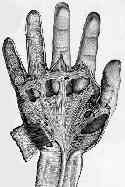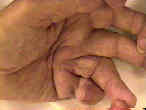 - See: Surgical Treatment of Dupuytren's:
- See: Surgical Treatment of Dupuytren's:
- Discussion:
- originally described by Baron Guillaume Dupuytren in 1831;
- ref: Guillaume Dupuytren: His Life and Surgical Contributions
- usually appears between age 40 to 60 years;
- disease occurs more often and is more severe in males or persons of Northern European Origin;
- may be associated w/ alcoholism, epilepsy (due to medications), and/or diabetes, and has autosomal dominance in some cases;
- patho-anatomy
- extracellular matrix-cytoskeletal connections at the surface of the specialized contractile fibroblast (myofibroblast) in Dupuytren disease.
- Dupuytren's contracture. An electron microscopic, biochemical, and clinical correlative study.
- The expression of platelet derived growth factor gene in Dupuytren's contracture. RM Terek et al. JBJS. Vol 77-A. 1995. p 1-9.
- etiology:
- associated w/ myofibroblast proliferation & increases in type III collagen and platelet derived growth factor B;
- immature type 3 collagen is proportionately increased in relation to normally occurring type I collagen within affected palmar fascia;
- contractile potential of myofibroblasts causes contraction of the collagenous palmar fascia and overlying skin and fingers;
- prognosis:
- a more aggressive disease is one that is associated w/:
- positive family history;
- onset before age 40;
- bilateral involvement;
- involvement of radial digits;
- ectopic disease (feet, penis);

- Clinical Findings:
- patients may present with a fixed flexion deformities in the MP, PIP, and rarely the DIP joints;
- occurs most often in the ring and little fingers, and is bilateral in 45%;
- patho-anatomy
- vascular:
- a digital Allen's test may reveal sluggish filling on either side of the affected digit;
- palm:
- fibrous nodules appear over pretendinous bands;
- involvement often begins w/ thickening of pre-tendinous cord over 4th ray;
- MP joint:
- mp contracture may be caused by pretendinous cord contracture or by contracture of spiral band;
- 20 to 30 deg flexion contracture is indication for surgery;
- abduction may be limited as natatory ligament becomes contracted;
- PIP joint:
- central cord is in continuity with pretendinous cord;
- spiral cord can manifest as an extension of pretendinous cord thru spiral band or at musculotendinous junction of intrinsics;
- any degree of flexion contracture of pip is indication for surgery;
- consider whether there is an associated trigger finger;
- thumb:
- may show a flexion deformity along w/ a web space contracture;
- ectopic disease:
- Ledderhose Disease
- associated fibrosis in feet (5% of patients);
- Peyronie's disease:
- associated fibrosis in penis and knuckle pads (3% of patients);
- these pts generally have a higher rate of recurrence;
- Dorsum of PIP: (knuckle pads);
- Non-Surgical Treatment:
- Dupuytren's nodules can be injected on a 6 week serial basis w/ 1-3 cc of triamcinolone (40 mg/ml);
- patients may note a softening and flattening of the nodules over months;
- clostridial collagenase:
- injections of 10,000 units into the area of maximal involvement may dissolve the Dupuytren cords;
- technique is most appropriate for disease limited to the palm and MP joints;
- results may be seen with in weeks;
- references:
- Injectable Collagenase Clostridium Histolyticum for Dupuytren's Contracture
- Collagen as a clinical target: nonoperative treatment of Dupuytren's disease
- Partial Improvement of Dupuytren Contracture Following a Wasp Sting
Surgical Treatment of Dupuytren's
- choice of incisions
- References:
Abductor digiti minimi involvement in dupuytren’s contracture of the small finger.

